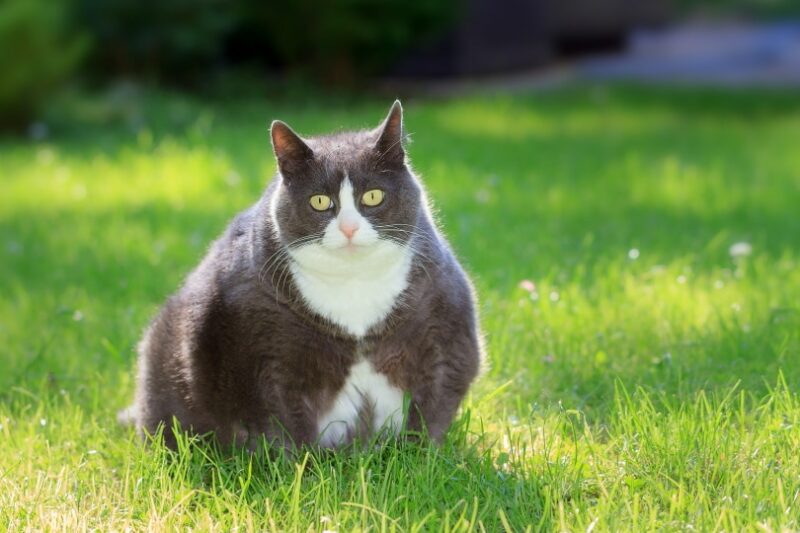Click to Skip Ahead
Are you finding that your cat is having trouble getting through her cat flap? Well, she’s not the only one! It is estimated that over 50% of adult cats are overweight. Obesity has been linked to many serious clinical diseases including diabetes and osteoarthritis. What’s more, carrying extra bodyweight has been found to shorten lifespan, so there are clearly many good reasons to keep your cat trim.
The most common factor leading to feline obesity is the overconsumption of calories. Unfortunately, it is so easy to accidentally give too many treats or serve meal portions that are a bit too large. Read on to learn more about how to determine if your cat is overweight and what you can do help get your cat back on track to a healthy weight.

How Do I Know if My Cat Is Overweight?
Every cat is unique when it comes to their bodyweight. Even cats of the same breed can have different ideal weights. As a general rule, your cat’s ideal weight will be what they weighed when they first entered adulthood. The best way to check if your cat is carrying more weight than she should is to evaluate her body condition score (BCS).
The BCS is a scale from 1 to 9 with 9 being severely obese and 1 being severely underweight. The ideal score for a cat on this chart is 5. Take a look at the score chart from the World Small Animal Veterinary Association to get a better idea of where your cat sits on this scale.
A cat with a BCS of 5 will have a visible waist when observed from above. You will be able to feel the ribs using only a slight amount of pressure around the chest area. The abdominal line should tuck upwards near the pelvis with little to no fat pad visible. If you have to push down to feel your cat’s ribs, they’re probably carrying a little extra!
However, studies have shown that beginners can easily get their cat’s BCS wrong—so double-check with a vet if you aren’t sure.
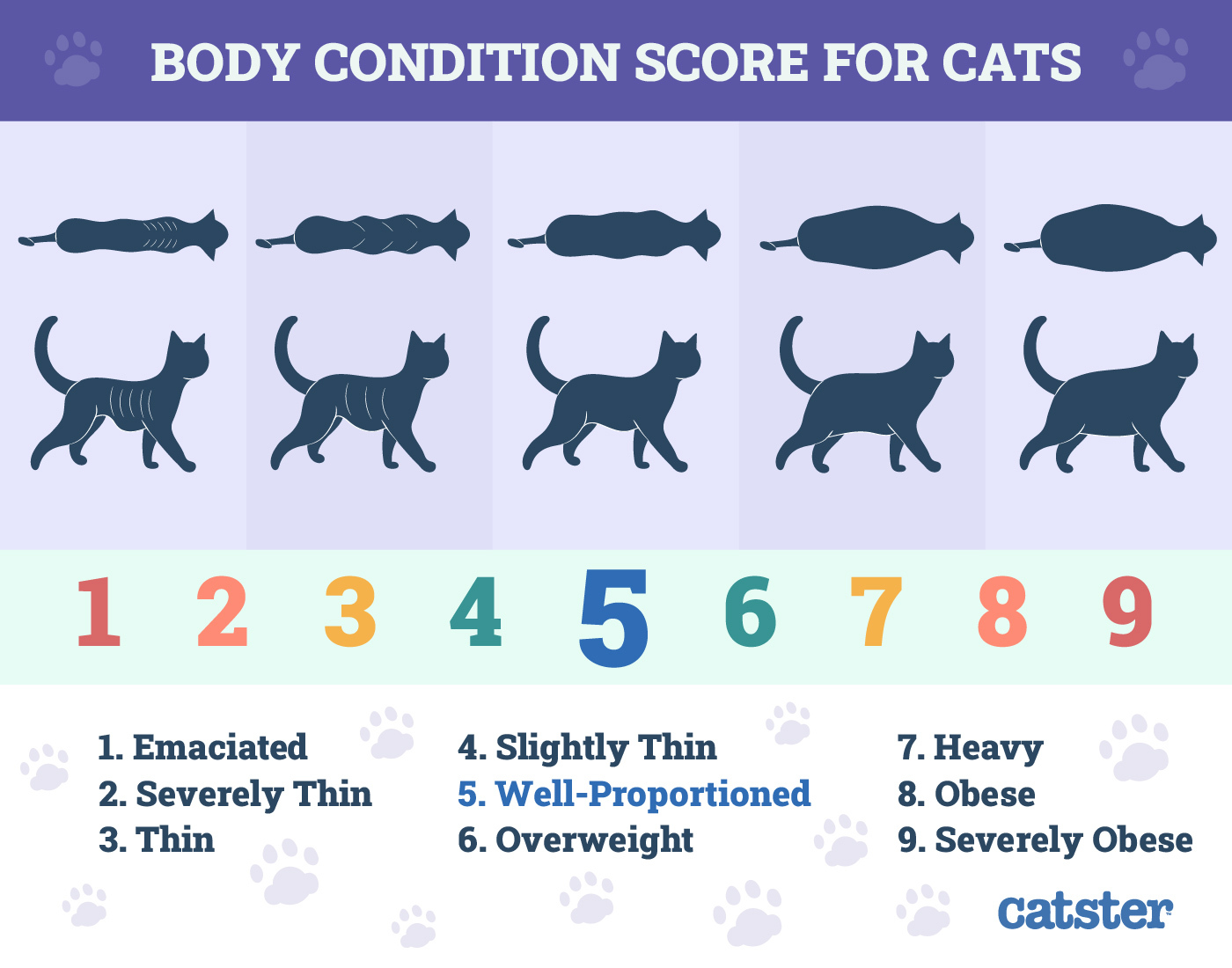
What Is a Safe Weight Loss for Cats?
When embarking on a medical weight loss plan you can expect your cat to lose 0.5-1% of body weight per week. Exceeding this amount is not advised as it could lead to some serious metabolic consequences, such as fatty liver disease. Some cats may lose less than 0.5% of their body weight per week, but it is important not to feel discouraged if this is the case. Your veterinarian or veterinary technician will be able to evaluate your progress and ensure that you’re staying on the right track. For some cats, it can take a few weeks of not losing any weight before they start to show progress.

How Much Should I Feed My Cat to Get Her to Lose Weight?
Every cat will be different when it comes to the amount to feed to lose weight safely. The daily caloric requirement can be calculated by your veterinarian or veterinary technician, or you can use a calorie calculator. Once you know how many calories to feed per day, you can determine how many grams of your chosen diet to feed. It is important that you measure out these amounts using a weighing scale. Cups are inaccurate and using them can cause you to inadvertently sneak too many calories into your cat’s bowl.
Can I Still Feed Treats During Weight Loss?
You can certainly still include treats in a weight loss plan! However, their caloric value should not make up more than 10% of the total daily allowance for calories. It is best to try to stick with low-calorie treats during weight loss. Some people have even had good success by simply separating out 10% of their regular weight-loss diet to use as treats throughout the day. This is an easy way to calculate your kitty’s treat allowance and she’ll also be able to eat more than if she was offered traditional high-calorie pet store treats.
Courgette (raw or steamed) is a low-calorie treat that is accepted by many cats. It has a high water content which can really help cats to feel fuller for longer.
Do I Need to Change My Cat’s Diet for Weight Loss? What Is the Best Weight Loss Food for Cats?
Depending on the weight loss plan that is best for your cat, your veterinarian or veterinary technician may recommend changing her food. You may be recommended a food that has a lower energy density, meaning that there are fewer calories in each bite. Diets that are designed for weight loss tend to have higher levels of protein and lower levels of fat. Another type of diet to consider is a high-moisture diet such as a canned food or one that comes in a pouch. Some cats may feel fuller eating these types of diets.
If you are going to change your cat’s food, ensure that this is done slowly. You should transition your cat to a new food over the course of a week by mixing your cat’s usual and new food together to help her get used to it. Gradually increase the proportion of new food offered each day until your cat is reliably eating only her new diet. Some cats are very picky, so don’t be surprised if it takes longer than a week for your cat to make the transition.
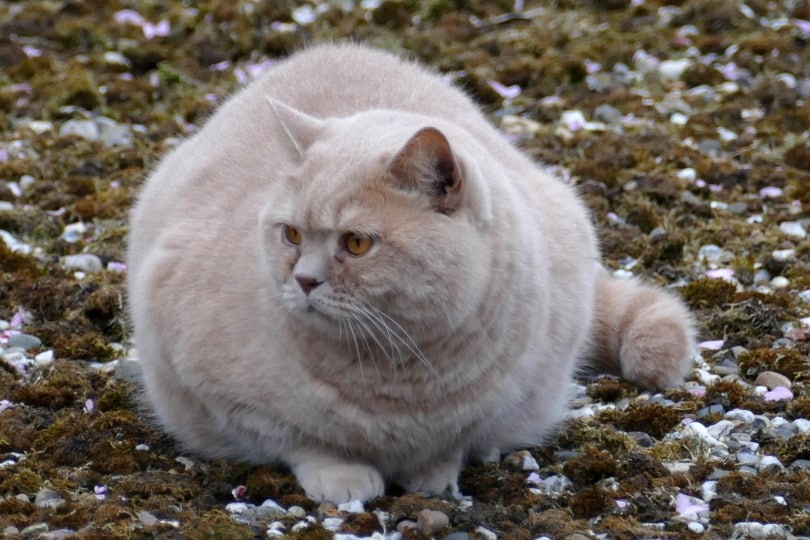

Losing Weight in Tricky Situations
Sometimes, it’s not just as easy as reducing the food. You might have a fat cat and a thin cat, or a kitten being fed high-calorie food in the same house. Let’s look at how to get a cat to lose weight in some common difficult situations.
How Can I Help a Cat Lose Weight With Multiple Cats?
Having multiple cats in the same household can make managing meals a bit tricky. Cats certainly have no qualms about stealing from each other’s food bowls! When working on a weight loss meal plan with more than one cat in the household, ensure that all cats are being fed at a certain time.
Try your best to separate cats during meal times, but it may not be as simple as using two different bowls. When it comes to a cat that is on a weight-loss plan, they can be very motivated to steal as many extra calories as they can from wherever they can get it! It may take some creativity to prevent food thieving. You might end up having to feed the cats in separate rooms of the house or at different times during the day. Some people even use microchip cat bowls or microchip cat flaps in cupboard doors to ensure each cat is only getting his or her food.
How Can I Help an Indoor Cat Lose Weight?
Indoor cats don’t have as much opportunity to exercise as outdoor cats. Even if your overweight cat seems to be a couch potato, most cats can be motivated to include some sort of exercise in their daily schedule. One thing to keep in mind is that most cats will prefer short and frequent play sessions. Don’t get discouraged if your cat only wants to chase a feather for just a minute or two! It is likely that she’ll be happy to repeat the same activity again soon after.
Try rotating your cat’s toys to keep things interesting. You don’t necessarily need “store bought” toys either—many cats are happy to jump in and out of cardboard boxes or bat the lid of a juice container around the hall. If your cat eats a kibble diet, you can use a portion of your cat’s daily allowance to play “kibble fetch”. Find a long hallway where you can throw the kibble and have your cat chase after it.
Puzzle feeders are a great way to feed your cat. They extend the time that it takes for your cat to finish her daily portion of food, and may help reduce begging behavior between meals. They don’t have to be store-bought either! You can get creative and make your own. Have a look at this website to get started.
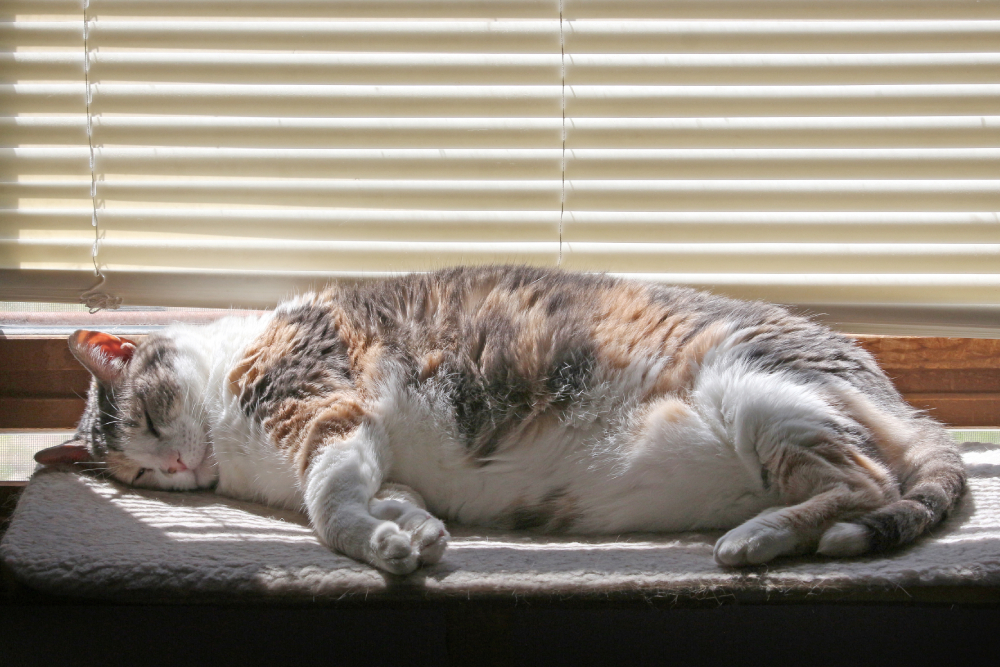

Top 9 Vet Tips for Weight Loss in Cats
Still struggling? These top tips from a vet might help!
1. Monitor Your Cat’s Weight Loss
Measure your cat’s bodyweight on a regular basis to track the success of the weight loss plan. Remember that your cat should lose around 0.5-1% of their bodyweight per week. Becoming familiar with body condition scoring is another great way to monitor progress. The target body condition score for an overweight cat is 5 out of 9.
2. Use Rewards Other Than Food When the Cat Is Seeking Attention
Oftentimes when our cat seeks out our attention, we automatically turn to the treats. However, cats can appreciate other activities equally as a demonstration of our affection. Instead of treats, try offering a grooming session with your cat’s favorite brush or initiate an impromptu play session. Even something as simple as a quiet moment giving pets and head scratches can be very rewarding for your cat. You don’t necessarily need high-calorie treats to have successful bonding time.
3. Join Your Veterinary Practice’s Weight Clinic
Many veterinary clinics will have a team dedicated to supporting your cat during their weight loss. You can get an appointment specifically to track your cat’s progress and make any revisions necessary to their tailored weight loss plan.
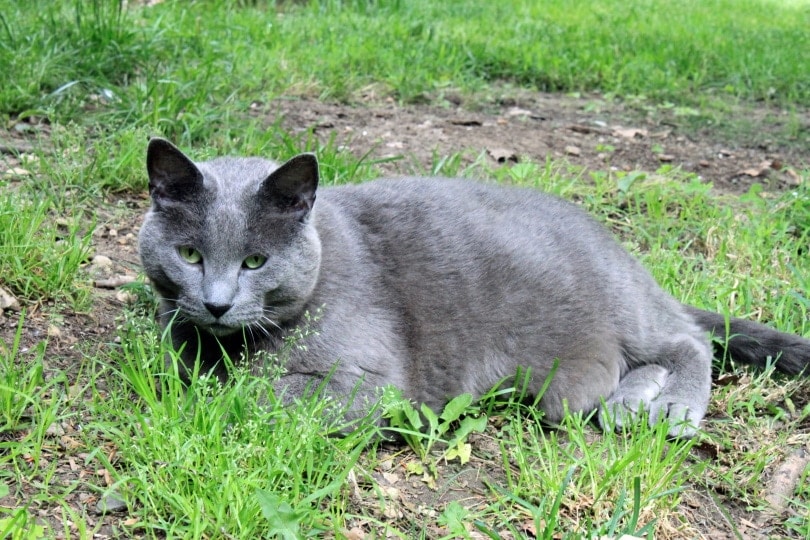
4. Don’t Reward Begging Behavior
As difficult as it is, it is important to not give in to food-motivated begging behavior from your cat. Not only will it reward the behavior but it can delay the results of your weight loss plan. If you find your cat’s begging behavior to be excessive, you might have to re-evaluate the meal plan. Some options to consider are to give more frequent, smaller meals throughout the day or change the food to one you can use in larger portions. Diets that are less energy-dense contain fewer calories per bite so your cat can eat more of it without overeating calories. Talk to your veterinarian about which choice would be best.
5. Provide More Enrichment in the Environment
By giving your cat more to do and explore in their environment, you may help them focus on activities other than eating.
- Increasing vertical space by using scratch posts with multiple platforms
- Having a selection of toys and play tunnels available to your cat throughout the day
- Providing scratch mats
- Hiding a portion of their daily food allowance around the home
- Providing a cat water fountain as a source of drinking water
- Growing a small patch of cat grass for your cat to nibble on
- Putting out different sizes of boxes around the home for your cat to play and hide in
While some cats have no trouble getting in their daily dose of exercise via the zoomies, others require a bit more encouragement to get active. The innovative Hepper Hi-Lo Cat Scratcher offers a 3-position design that provides cats with a variety of levels to play on, each engaging their full body and muscles. The durable cardboard scratching pad is an enticing cat-friendly place to climb, stretch, and claw, fulfilling their instinctual need to scratch.
If you are looking to improve your cat's health and increase their energy, check out the Hepper Hi-Lo Cat Scratcher. At Catster, we’ve admired Hepper for many years, and decided to take a controlling ownership interest, so that we could benefit from the outstanding designs of this cool cat company!
6. Feed Your Kitty in Small Bites
If you are able to sit with your cat during mealtime, you can feed your cat in small bites. If your cat is eating a dry kibble diet, slowly dole out the meal one kibble at a time. With a wet diet you can add the meal to the food bowl one tablespoon at a time. This will prolong the length of your kitty’s meal and help to prevent begging behavior between meals.
7. Prevent Food Theft
If your cat is suddenly on a restricted diet, they may find themselves a bit hungrier than usual. Even slight hunger is enough to motivate your cat to hunt for whatever they can find to eat. Ensure that your cat’s food is properly secured and that the food of any other pets in the house is out of reach. Cats may even develop a liking for people food so ensure that all food in the kitchen and pantry are safely out of reach.
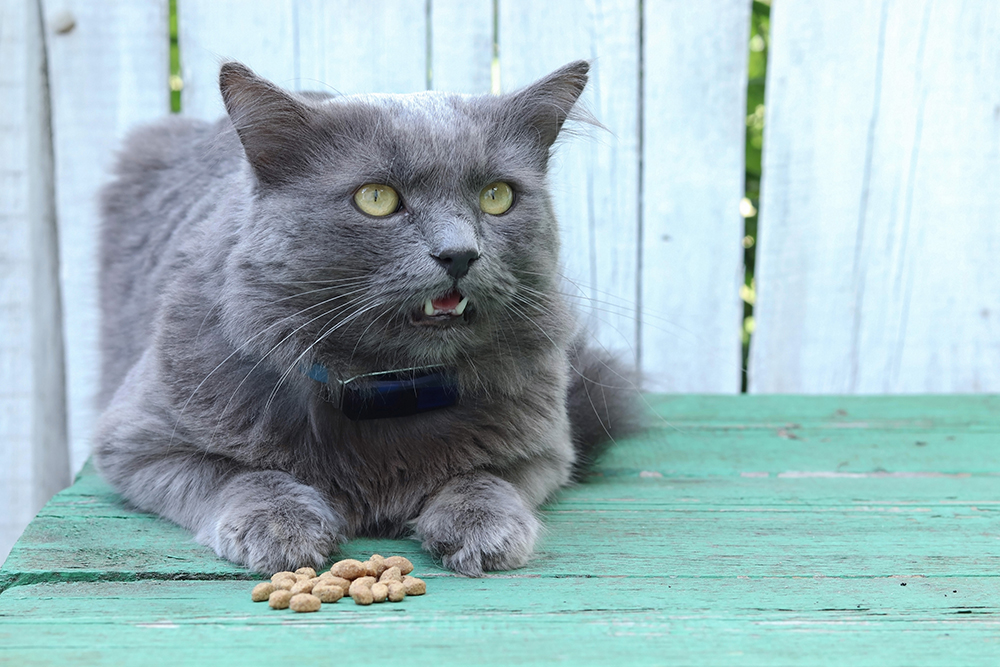
8. Get Everyone on Board
Getting a cat to lose weight is a team effort. Make sure that everyone in your household is aware of the rules surrounding your cat’s new diet. All treats given in a day can only make up 10% of the total daily calories! It is important to communicate which treats are given when and by whom so that you can plan to stay within the treat budget. If you have an outdoor cat that visits neighbors for snacks, ask them to avoid giving treats while your cat is on her diet plan.
9. Don’t Give Up
It is well-known fact that weight loss can be quite challenging in cats. Achieving significant weight loss can take some time and dedication. Your cat can lose up to 1% of their bodyweight per week but this can be as low as 0.25% or less. When embarking on a weight loss plan, sometimes simply not gaining weight for one week will be a victory. If you are concerned that your cat is not losing enough, you can always review your plan and target weight loss with a veterinary professional.

Conclusion
Helping a cat lose weight can be hard work, but working closely with your veterinary team is the best way to achieve success. Switching to a prescription weight loss diet can help, but make sure you weigh out the food, or you still risk giving too many calories!
Related Reads:
- Are Abdominal Fat Pads on Cats Normal? Our Vet Answers
- Why Is My Cat Not Losing Weight? Vet Approved Reasons & Advice
Featured Image Credit: Dennis van de Water, Shutterstock

